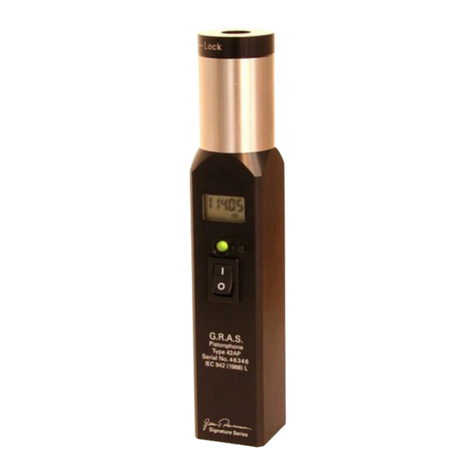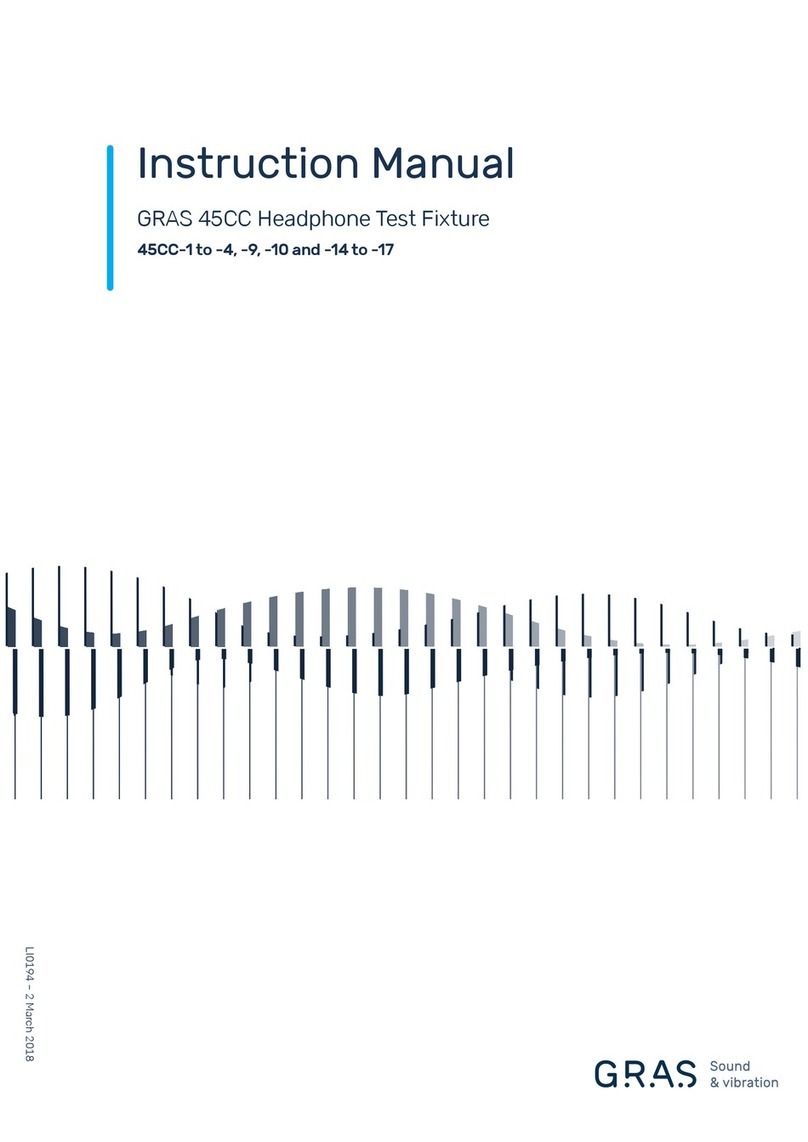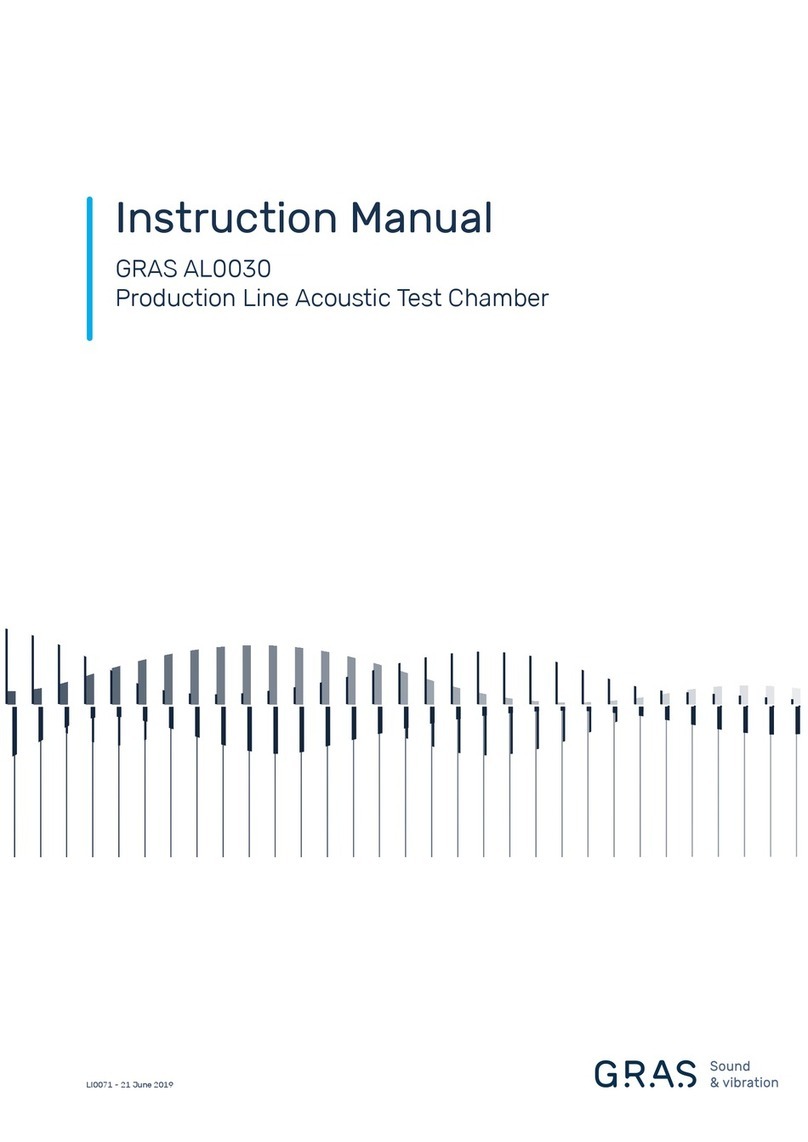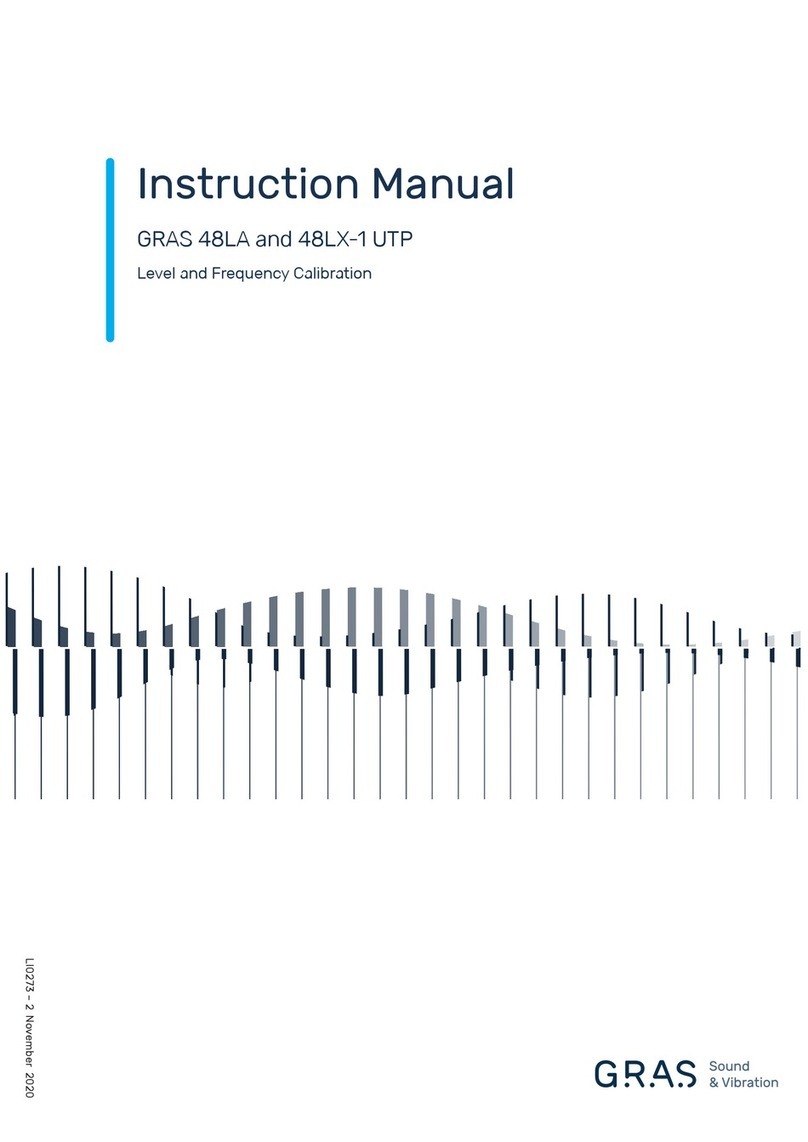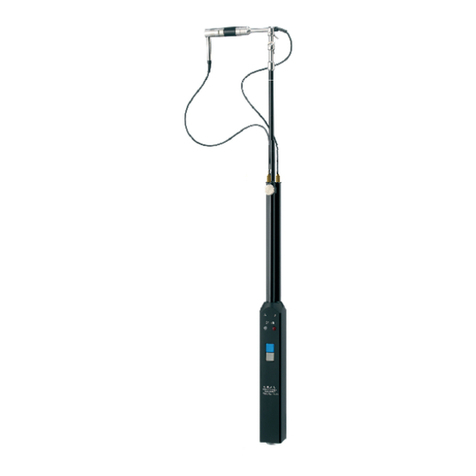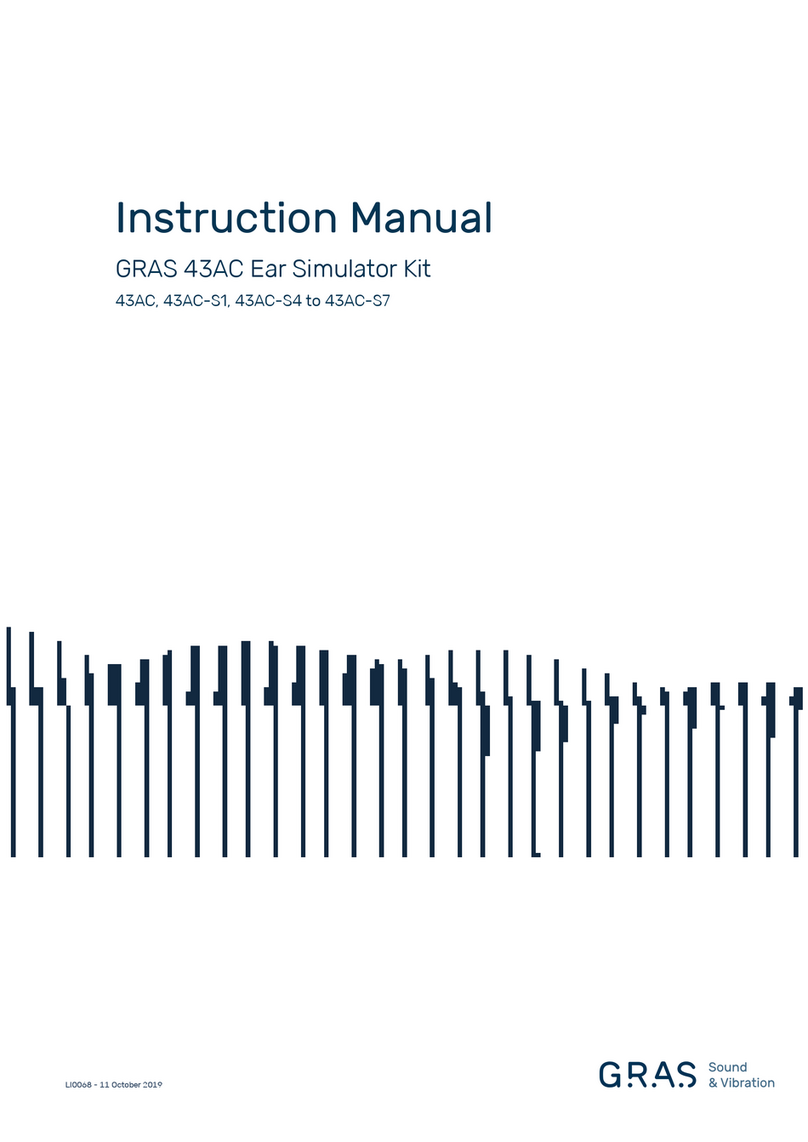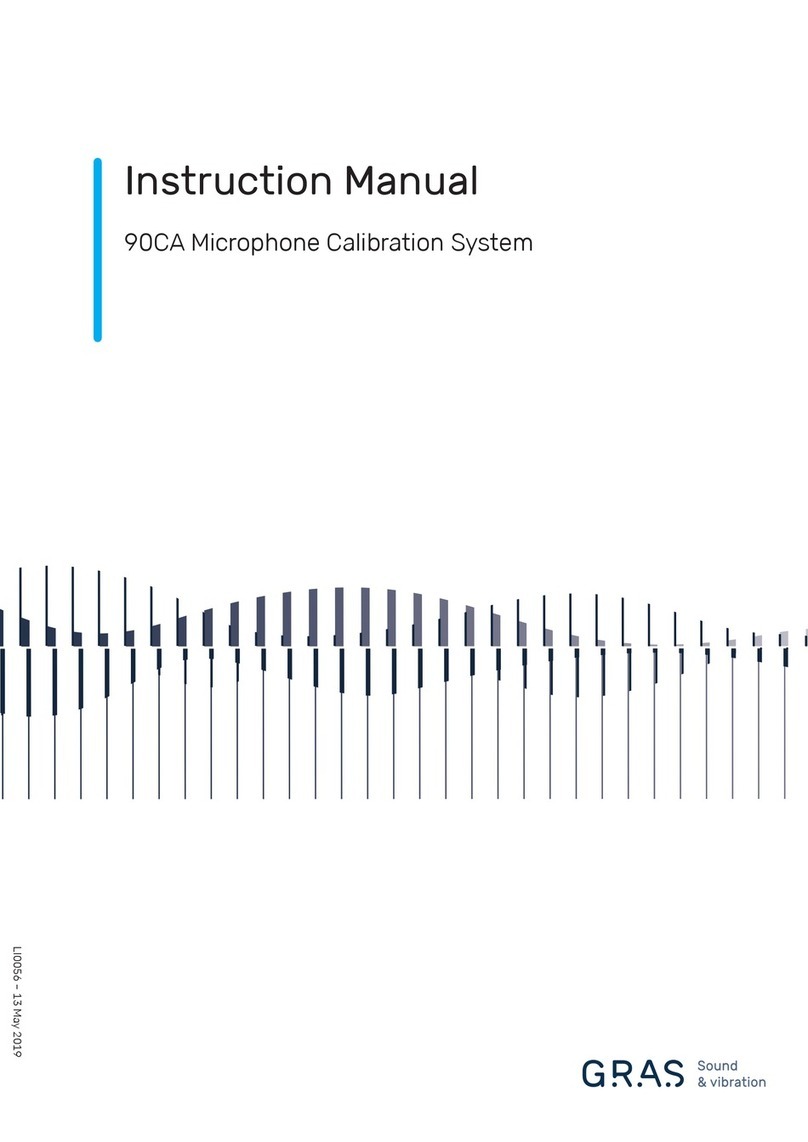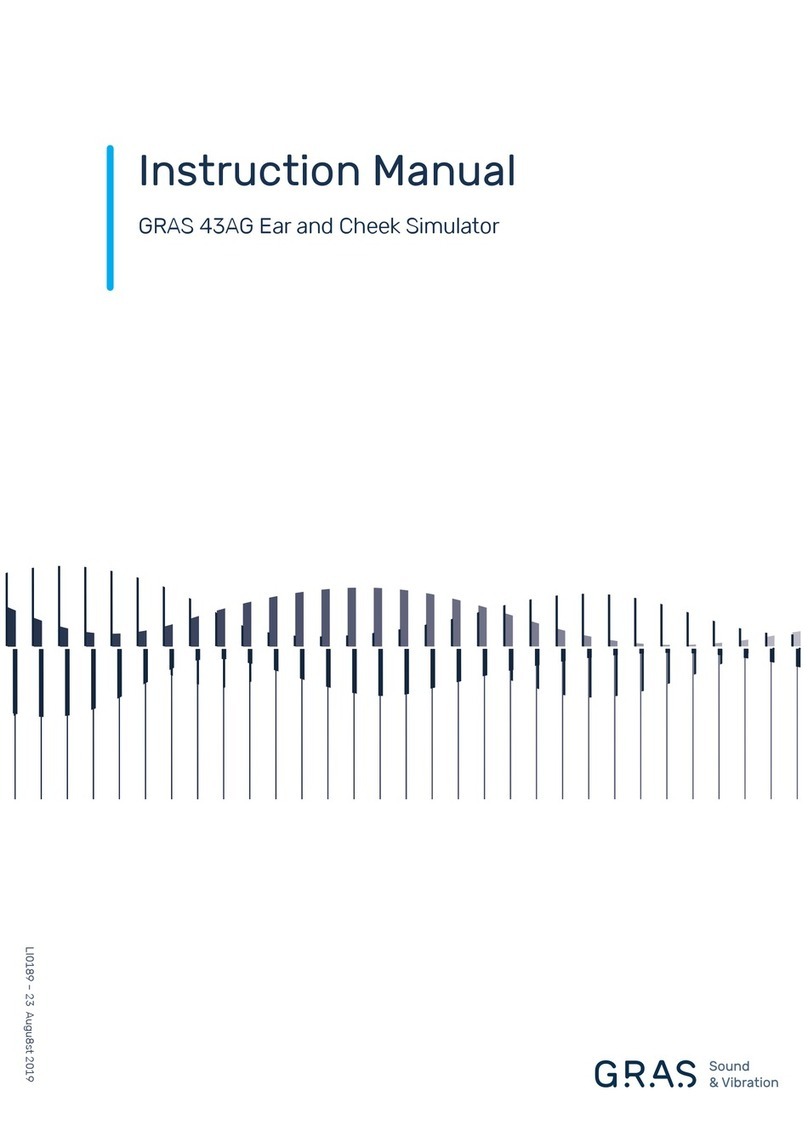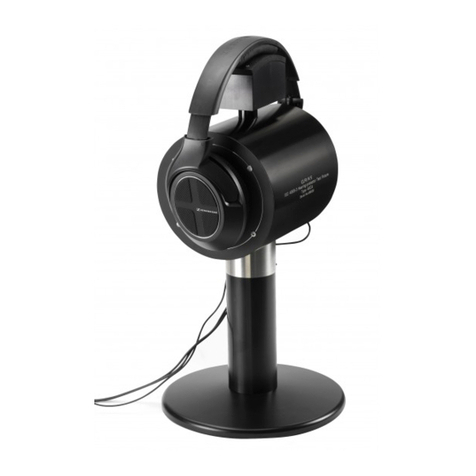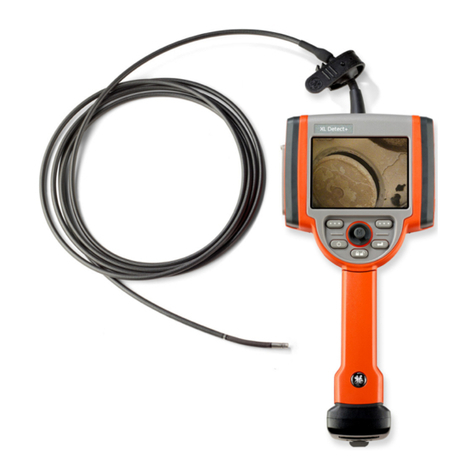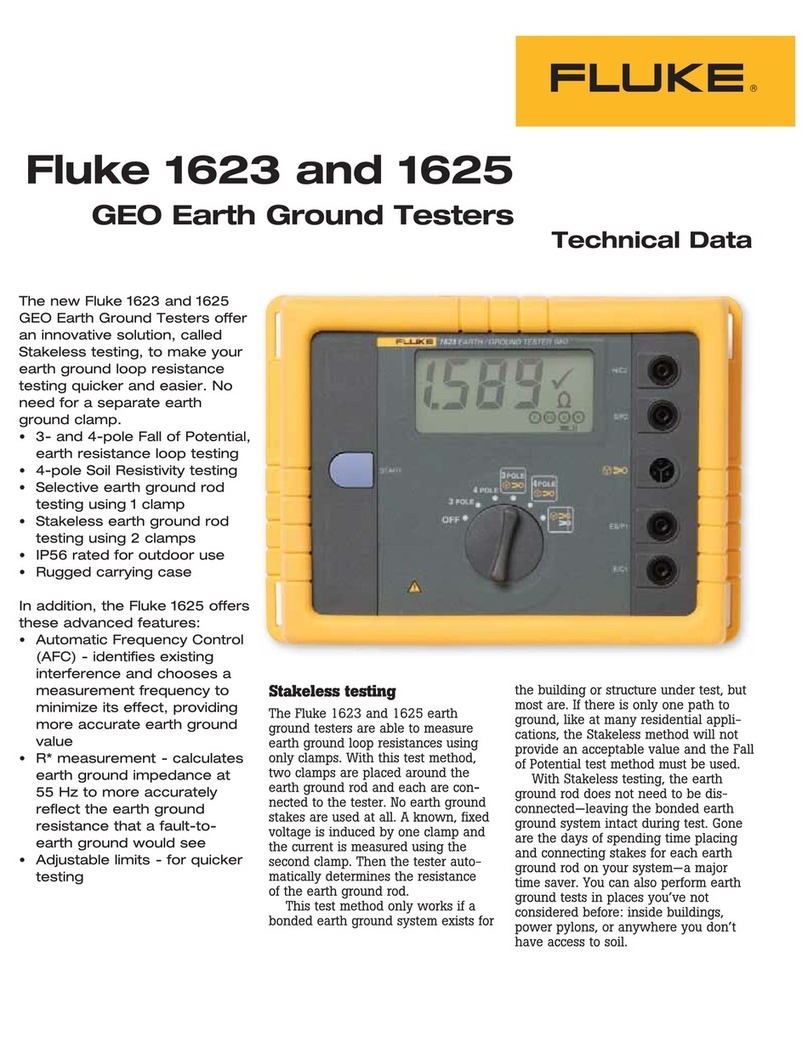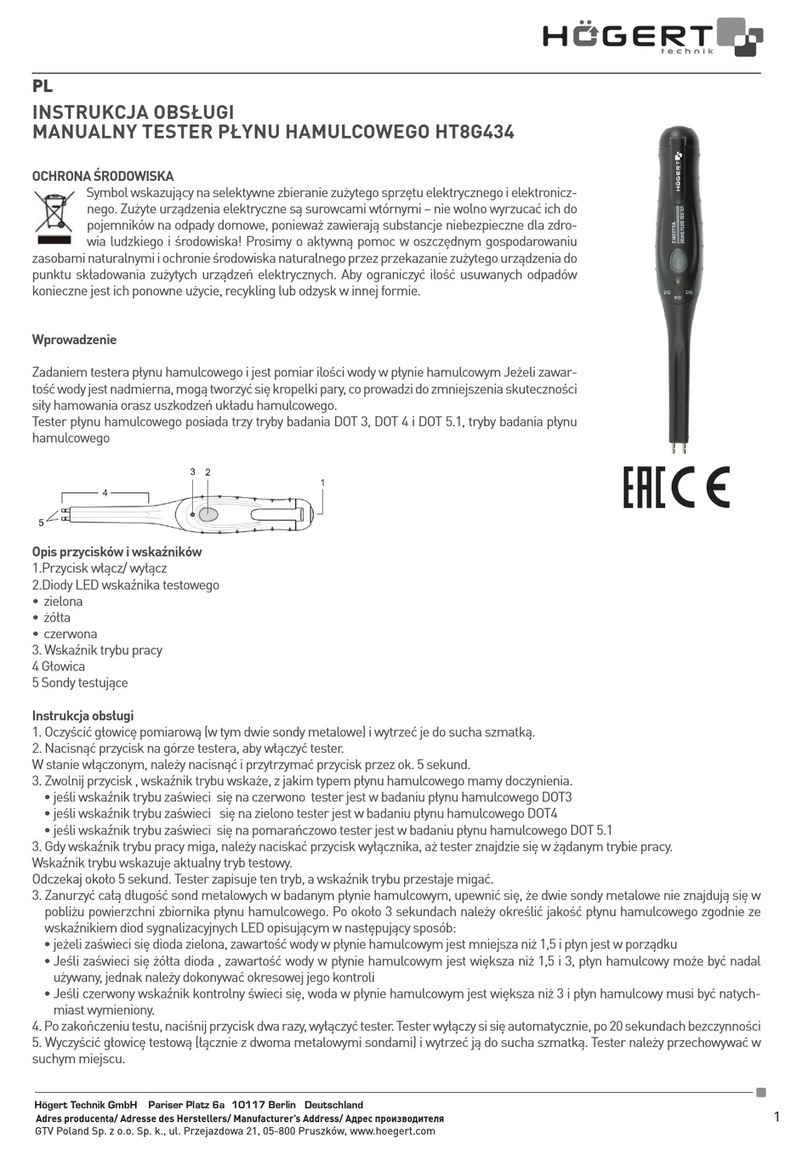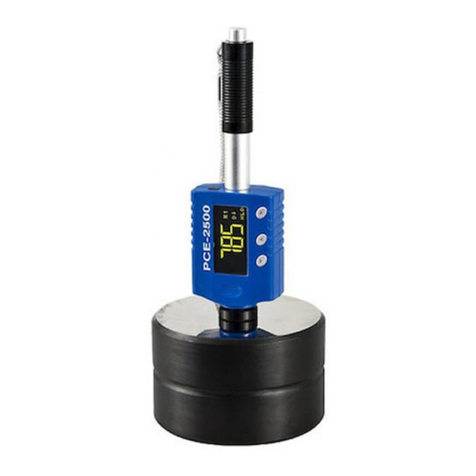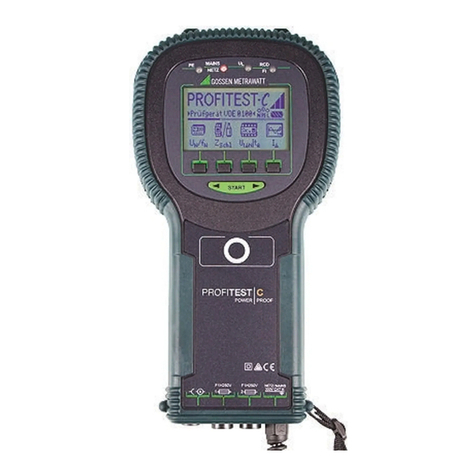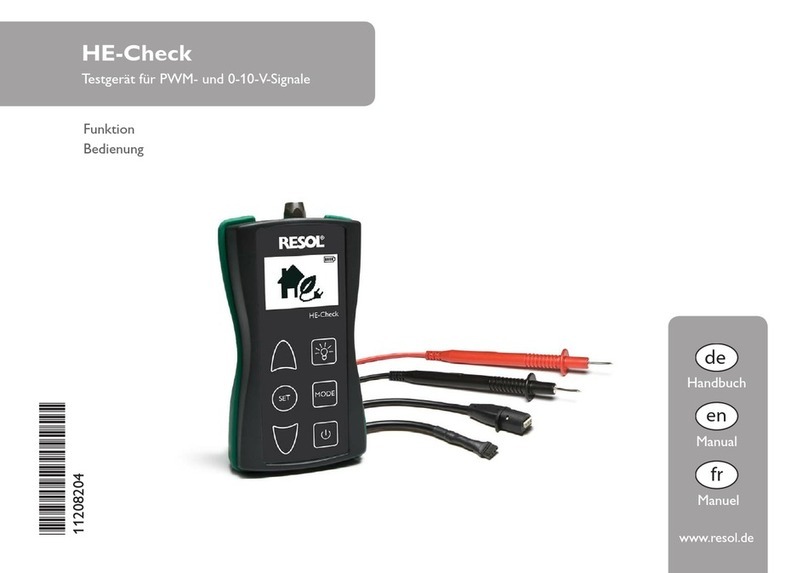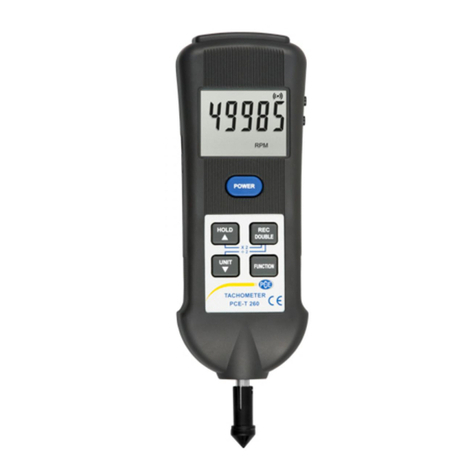GRAS 42AA User manual

LI0125
Instruction Manual
Pistonphone Type 42AA / 42AA-S1
Skovlytoften 33, 2840 Holte, Denmark
SOUND & VIBRATION
G R A S
...
.

G.R.A.S. Sound & Vibration
Pistonphone Types 42AA/42AA-S1 - Page 2
Note: unless individually specied, the term “Pistonphone” through-
out this document refers to both types, i.e. Type 42AA and Type
42AA-S1.
Before shipment, remove the batteries and wrap separately. Assure cautious han-
dling during transport. Remove the battery as soon as it is discharged or if the 42AA
is stored for a prolonged period of time. Leakage from the batteries may otherwise
destroy the electronic components.
Revision History
Any feedback or questions about this document are welcome at [email protected].
Revision Date Description
1 1 February 2010 First publication
24 July 2013 Section 3.1 “Shipment and transport” added
Copyright Notice
© 2013 G.R.A.S. Sound & Vibration A/S
http://www.gras.dk
Any technical documentation that is made available by G.R.A.S. is the copyrighted work of G.R.A.S.
and is owned by G.R.A.S.
The content in this document is subject to change without notice. G.R.A.S. Sound & Vibration A/S is
not liable or responsible for any errors or inaccuracies that may appear in this document.
Trademarks
Product names mentioned in this document may be trademarks or registered trademarks of their
respective companies and are hereby acknowledged.

G.R.A.S. Sound & Vibration
CONTENTS
1. General Description ..............................................4
1.1 Operating Frequency ...............................................4
1.2 Calibration Level . . . . . . . . . . . . . . . . . . . . . . . . . . . . . . . . . . . . . . . . . . . . . . . . . . . 4
2. Theory .........................................................6
2.1 Principle .........................................................6
2.2 Volume Corrections. . . . . . . . . . . . . . . . . . . . . . . . . . . . . . . . . . . . . . . . . . . . . . . . . 6
2.3 Static-pressure Corrections ..........................................7
2.3.1 Barometer ..........................................................8
3. Handling and Operation . . . . . . . . . . . . . . . . . . . . . . . . . . . . . . . . . . . . . . . . . . . 9
3.1 Shipment and Transport .............................................9
3.2 Batteries .........................................................9
3.3 Calibrating Microphones . . . . . . . . . . . . . . . . . . . . . . . . . . . . . . . . . . . . . . . . . . . . . 9
3.3.1 Microphone Size .....................................................9
3.3.2 ½-inch Microphones. . . . . . . . . . . . . . . . . . . . . . . . . . . . . . . . . . . . . . . . . . . . . . . . . . . 9
3.3.3 ¼-inch Microphones. . . . . . . . . . . . . . . . . . . . . . . . . . . . . . . . . . . . . . . . . . . . . . . . . . 10
3.3.4 ⅛-inch Microphones. . . . . . . . . . . . . . . . . . . . . . . . . . . . . . . . . . . . . . . . . . . . . . . . . . 11
3.3.5 1-inch Microphones ..................................................12
3.4 Calculation of Microphone Sensitivity . . . . . . . . . . . . . . . . . . . . . . . . . . . . . . . . . . 13
4. Specications ..................................................14
A Appendix ......................................................16
A.1 Corrections for Static Ambient Pressure. . . . . . . . . . . . . . . . . . . . . . . . . . . . . . . . 16
A.2 Corrections for Humidity . . . . . . . . . . . . . . . . . . . . . . . . . . . . . . . . . . . . . . . . . . . . 16

G.R.A.S. Sound & Vibration
Pistonphone Types 42AA/42AA-S1 - Page 4
1. General Description
The G.R.A.S. Pistonphone (Fig. 1.1) is a battery-operated, precision sound source for accurate
and reliable calibration of measurement microphones, sound level meters and other sound
measuring equipment.
• Type 42AA includes barometer type ZC0002K.
• Type 42AA-S1 includes barometer type RA0168.
Otherwise, there is no difference between the two types.
1.1 Operating Frequency
The Pistonphone type 42AA and type 42AA-S1 operates at a frequency of 250Hz.
1.2 Calibration Level
With a microphone inserted in the Pistonhone’s coupler and the Pistonphone and switched on,
the nominal calibration level is:
• 114 dB
1 re. 20 µPa
• 105.4 dBA re. 20 µPa (with A-weighting applied)
At a static ambient pressure of 1013 hPa, no further correction factors need be applied. An indi-
vidual calibration chart is delivered with each Pistonphone.
* True centre frequency of a 250 Hz ⅓-octave band lter
1 114 dB is equivalent to 10 Pa
Fig. 1.1 Pistonphone
The Pistonphone is an extremely stable laboratory-standard sound source which can also be
used for eld calibrations - it retains its high accuracy even under hostile environmental conditions.
The Pistonphone complies with all the requirements of IEC Standard 942 (1988) Sound Calibra-
tors Class 1 when corrected with barometer ZC0002K as well as Class 0 when corrected with
barometer RA0168. Type 42AA includes ZC0002K and Type 42AA-S1 includes RA0168.

G.R.A.S. Sound & Vibration
Pistonphone Types 42AA/42AA-S1 - Page 5
The Pistonphone works on the principle of two reciprocating pistons actuated by a precision-
machined cam disc with a sinusoidal prole. The rotation speed of the cam disc is controlled to
within 0.5% via a tachometer signal in a feed-back loop.
The operating procedure is straight forward, simply t the microphone into the coupler of the
Pistonphone and switch on. The Pistonphone will now produce a constant sound pressure level
on the diaphragm of the microphone.
The Pistonphone is normally delivered with a coupler for calibrating ½-inch microphones. Adapt-
ers for calibrating ¼-inch and ⅛-inch microphones are included. A coupler (RA0023) for calibrat-
ing 1-inch microphones is also available.

G.R.A.S. Sound & Vibration
Pistonphone Types 42AA/42AA-S1 - Page 6
2. Theory
2.1 Principle
The Pistonphone works on the principle of a pair of similar opposing, reciprocating pistons
(Fig. 2.1) actuated by a precision-machined cam disc with a sinusoidal (SHM) prole. The cam
disc is mounted on the shaft of a small electric motor. The prole of the cam disc is such that the
pistons follow a sinusoidal movement at a frequency equal to four times the speed of rotation.
This results in a corresponding sinusodial variation in the effective volume of the closed coupler
and, consequently, an acoustic signal within it. The RMS pressure, P (in pascals), of this acous-
tic signal is given by:
Where :
γ is the ratio of specic heats for the gas in the coupler (for air this is 1.402 at 20 °C and
1 atm.)
P
0 is the ambient pressure in pascals (Pa)
A
p is the cross-sectional area of one piston in square metres (m
2)
S is the stroke length of the pistons in metres (m)
V is the coupler volume in cubic metres (m
3)
A
pand S are determined by the physical dimensions of the pistons and the cam disc; the ambi-
ent pressure refers, in most cases, to the barometric pressure of the atmosphere.
2.2 Volume Corrections
The volume of the coupler is dened partly by the dimensions of the coupler itself and partly the
effective load volume of the microphone. The effective load volume of the microphone is sum of
the equivalent volume and the front cavity volume. The front cavity volume of the microphone
is the volume between the microphone’s diaphragm and the protection grid plus the volume
contained in the slits of the protection grid.
The equivalent volume of the microphone is the apparent volume of the microphone behind the
diaphragm. Since the diaphragm is not perfectly stiff, it will be deected slightly by a sound pres-
sure. This slight deection of the diaphragm can be considered as equivalent to a small volume
and, as such, should be added to the sum of the grid and coupler volumes. Since the grid and
equivalent volumes can vary slightly from one type of microphone to another, the total volume of
the coupler will, accordingly, also vary slightly.
Fig. 2.1 Principle of the Pistonphone
P = γ⋅P 0⋅2 A p⋅S
V ⋅√ 2(1)

G.R.A.S. Sound & Vibration
Pistonphone Types 42AA/42AA-S1 - Page 7
A change in the total volume of the coupler will cause a change in the sound pressure level
generated within the coupler. A change in the sound pressure level ∆ P, in decibels, for a change
in coupler volume ∆ V is given by:
Where:
V = 15540mm
3, including the effective load volume of 40AG
∆ V is the equivalent volume correction
The Pistonphone is calibrated using a G.R.A.S. ½-inch Microphone Type 40AG. Since all
G.R.A.S. ½-inch microphones have the same grid volume, the only correction necessary when
calibrating the various types is the correction for the various equivalent volumes*.
Table 2.1 shows the equivalent volumes of G.R.A.S. ½-inch microphones and the correspond-
ing Pistonphone corrections.
* The G.R.A.S. Microphone Type 40AG is equivalent to the Brüel & Kjær Type 4134 and the volume correction for these are
0 dB. As a matter of interest, the volume correction for a G.R.A.S. Type 40AU and a Brüel & Kjær Type 4180 is 0.077 dB.
The equivalent volume uncertainty is ±7mm
3. The correction uncertainty is ±0.004 dB.
No equivalent volume correction is needed for calibration of ¼-inch microphones (G.R.A.S. type
40BD, 40BE, 40BF, 40BP) using the adaptor RA0049, nor 1-inch microphone (G.R.A.S. type
40EN) using the adaptor RA0023.
When calibrating 1/8-inch microphones (G.R.A.S. type 40DD, 40DP) using the adaptor RA0069
the equivalent volume correction is +19mm
3 and requires a correction -0.011 dB.
∆ P = 20 ⋅Log ⋅( )
V
V + ∆ V
(2)
Table 2.1 Corrections for G.R.A.S. ½-inch microphones
re. the G.R.A.S. Microphone Type 40AG
G.R.A.S. Equiv-volume Correction
Mic. Type correction (mm
3) (decibels)
40AC – 20 0.011
40AD 20 – 0.011
40AE 25 – 0.014
40AF 30 – 0.017
40AN 25 – 0.014
40AP 25 – 0.014
40AQ 15 – 0.008
40AR 25 – 0.014
40AU – 137 0.077

G.R.A.S. Sound & Vibration
Pistonphone Types 42AA/42AA-S1 - Page 8
2.3 Static-pressure Corrections
The Pistonphone is factory adjusted to give a nominal sound pressure level of 114 dB re.
20 µPa. This nominal value is valid for the following ambient reference conditions:
• Temperature 23º C
• Static pressure 1013 hPa
• Relative humidity 50 %
For other static pressures, the nominal Pistonphone level will have to be corrected. The correc-
tion ∆ P, in decibels, is given by the following equation:
∆ P = 20 ⋅Log ⋅( )
P
a
P
r
(3)
Where:
P
a = measured static ambient pressure (hPa)
P
r = reference static pressure (1013 hPa)
The corrections for ambient static pressure are shown in Fig. 2.2 (see also Appendix A.1 for an
extended pressure range). These values should be applied to the nominal Pistonphone level.

G.R.A.S. Sound & Vibration
Pistonphone Types 42AA/42AA-S1 - Page 9
2.3.1 Barometer
The Pistonphone is delivered with a small barometer as a standard accessory for use when
applying static-pressure corrections.
• Type 42AA is delivered with barometer ZC0002K
• Type 42AA-S1 is delivered with barometer RA0168
Analogue Barometer ZC0002K (Fig. 2.3)
This barometer has the static-pressure corrections printed directly on its scale.
Digital Barometer RA0168 (Fig. 2.4)
This has an LCD which can display (via a toggle button) either the static-pressure correction
(e.g. – 0.13 dB) or the ambient static pressure (e.g. 997 hPa). It runs on standard 9 V battery
which can be accessed by removing the back plate which is held in place by four screws.
Fig. 2.3 Barometer ZC0002K Fig. 2.4 Barometer RA0168
Fig. 2.2 Corrections for static ambient pressure
On/Off switch
Toggle button

G.R.A.S. Sound & Vibration
Pistonphone Types 42AA/42AA-S1 - Page 10
3. Handling and Operation
3.1 Shipment and Transport
Before any major shipment where rough handling is to be expected, remove the batteries to pro-
tect connectors and other internal parts from accidental damage.
Before shipment, remove the batteries and wrap separately.
Assure cautious handling during transport.
3.2 Batteries
The Pistonphone runs on four 1.5 V batteries (type AA [LR6]). To install or replace the batteries,
remove the lid of the battery compartment which is held in place by the screw shown in Fig. 3.1.
Slide the lid in the direction shown after removing the screw. Insert four new batteries observing
the correct polarity as indicated on the gure inside the battery compartment.The Pistonphone
can operate continuously for about 20 hours on a new set of batteries.
Remove the battery as soon as it is discharged or if the 42AA is stored for a
prolonged period of time. Leakage from the batteries may otherwise destroy
the electronic components.
3.3 Calibrating Microphones
3.3.1 Microphone Size
The Pistonphone is normally delivered ready to calibrate ½-inch microphones. For ¼-inch and
⅛-inch microphones, special adapters are included and for 1-inch microphones, a 1-inch cou-
pler (available from G.R.A.S.) has to be tted. Each case is described in the following sections.
3.3.2 ½-inch Microphones
To calibrate a ½-inch measurement microphone, rst loosen the microphone retention collar as
shown in Fig. 3.2. Then insert the microphone into the ½-inch coupler
1 as shown in Fig. 3.3.
Make sure that the microphone is all the way in, then tighten the microphone retention ring so
that the microphone is held rmly in place.
Fig. 3.1 Access to batteries
Fig. 3.2 Loosening the microphone retention collar
1 The ½-inch coupler is individual calibrated with the pistonphone, and these must be considered as a pair

G.R.A.S. Sound & Vibration
Pistonphone Types 42AA/42AA-S1 - Page 11
Switch the Pistonphone on via the on/off (I/0) button. The LED above the on/off button is a
dual-colour LED for showing red or green. The LED shows green if the Pistonphone is operating
properly at the specied frequency. If the LED shows red or ashing red, the Pistonphone is not
operating at the specied frequency and the batteries should be changed (see section 3.2).
Wait approximately for 15 seconds for the static pressure in both the Pistonphone and the
microphone to stabilise, and for the microphone itself to stabilise within the coupler.
The static pressure within the coupler volume is equalised via an air-equalisation tube located
under the cap which protects the pistons and retention spring shown in Fig. 2.1.
With the Pistonphone switched on, the microphone is subjected to a sound pressure level L
C
given as the sum of the Pistonphone’s nominal sound pressure level L
N (found on the piston-
phone’s calibration chart as “Sound Pressure Level”), the static pressure correction L
B and the
volume correction L
V, i.e.:
Fig. 3.3 ½-inch microphone inserted in the coupler
3.3.3 ¼-inch Microphones
To calibrate a ¼-inch measurement microphone, rst loosen the microphone retention collar as
shown in Fig. 3.2. Then insert the ¼-inch microphone adapter (RA0049) into the ½-inch coupler
as shown on Fig. 3.4. Make sure that the adapter is all the way in, then tighten the microphone
retention collar so that the adapter is held rmly in place. Insert the ¼-inch microphone into the
¼-inch adapter.
Switch the Pistonphone on via the on/off (I/0) button. The LED above the on/off button is a
dual-colour LED for showing red or green. The LED shows green if the Pistonphone is operating
properly at the specied frequency. If the LED shows red or ashing red, the Pistonphone is not
operating at the specied frequency and the batteries should be changed (see section 3.2).
Fig. 3.4 ¼-inch microphone adapter
inserted in the coupler
L
C= L
N+ L
B+ L
V(4)

G.R.A.S. Sound & Vibration
Pistonphone Types 42AA/42AA-S1 - Page 12
Wait approximately for 15 seconds for the static pressure in both the Pistonphone and the
microphone to stabilise, and for the microphone itself to stabilise within the coupler.
The static pressure within the coupler volume is equalised via an air-equalisation tube located
under the cap which protects the pistons and retention spring shown in Fig. 2.1.
With the Pistonphone switched on, the microphone is subjected to a sound pressure level L
C
given as the sum of the Pistonphone’s nominal sound pressure level L
N (found on the piston-
phone’s calibration chart as “Sound Pressure Level”), the static pressure correction L
B and the
volume correction L
V, i.e.:
3.3.4 ⅛-inchMicrophones
To calibrate a ⅛-inch measurement microphone, rst loosen the microphone retention collar as
shown in Fig. 3.2. Then insert the ⅛-inch microphone adapter (RA0069) into the ½-inch coupler
as shown on Fig. 3.4. Make sure that the adapter is all the way in, then tighten the microphone
retention collar so that the adapter is held rmly in place. Insert the ⅛-inch microphone into the
⅛-inch adapter.
Switch the Pistonphone on via the on/off (I/0) button. The LED above the on/off button is a
dual-colour LED for showing red or green. The LED shows green if the Pistonphone is operating
properly at the specied frequency. If the LED shows red or ashing red, the Pistonphone is not
operating at the specied frequency and the batteries should be changed (see section 3.2).
Wait approximately for 15 seconds for the static pressure in both the Pistonphone and the
microphone to stabilise, and for the microphone itself to stabilise within the coupler.
The static pressure within the coupler volume is equalised via an air-equalisation tube located
under the cap which protects the pistons and retention spring shown in Fig. 2.1.
With the Pistonphone switched on, the microphone is subjected to a sound pressure level L
C
given as the sum of the Pistonphone’s nominal sound pressure level L
N (found on the piston-
phone’s calibration chart as “Sound Pressure Level”), the static pressure correction L
B and the
volume correction L
V, i.e.:
Fig. 3.5 ⅛-inch microphone adapter
inserted in the coupler
L
C= L
N+ L
B+ L
V(5)
L
C= L
N+ L
B+ L
V(6)

G.R.A.S. Sound & Vibration
Pistonphone Types 42AA/42AA-S1 - Page 13
3.3.5 1-inch Microphones
To calibrate a 1-inch measurement microphone, the standard ½-inch coupler has to be replaced
by the optional 1-inch coupler
1 (RA0023), see Fig. 3.6. Unscrew the ½-inch coupler from the
Pistonphone body. The pistons and retention spring shown in Fig. 2.1 are protected so there
is no risk of accidentally damaging these parts when removing the coupler. Screw the 1-inch
coupler (RA0023) onto the Pistonphone body. Then insert the 1-inch microphone into the 1-inch
coupler. Make sure that the microphone is all the way in.
Switch the Pistonphone on via the on/off (I/0) button. The LED above the on/off button is a
dual-colour LED for showing red or green. The LED shows green if the Pistonphone is operating
properly at the specied frequency. If the LED shows red or ashing red, the Pistonphone is not
operating at the specied frequency and the batteries should be changed (see section 3.2).
Wait approximately for 15 seconds for the static pressure in both the Pistonphone and the
microphone to stabilise, and for the microphone itself to stabilise within the coupler.
The static pressure within the coupler volume is equalised via an air-equalisation tube located
under the cap which protects the pistons and retention spring shown in Fig. 2.1.
With the Pistonphone switched on, the microphone is subjected to a sound pressure level L
C
given as the sum of the Pistonphone’s nominal sound pressure level L
N (found on the piston-
phone’s calibration chart as “Sound Pressure Level”), the static pressure correction L
B and the
volume correction L
V, i.e.:
Fig. 3.6 1-inch and ½-inch couplers
1 The 1-inch coupler is individual calibrated with the pistonphone, and these must be considered as a pair.
L
C= L
N+ L
B+ L
V(7)

G.R.A.S. Sound & Vibration
Pistonphone Types 42AA/42AA-S1 - Page 14
3.4 Calculation of Microphone Sensitivity
The sensitivity of a microphone under test can be calculated via a measurement of the micro-
phone’s output voltage. If the measured output voltage is V
o, and the sound pressure level in
the Pistonphone’s coupler is L
C (decibels), the microphone sensitivity S is given by:
The value 20 μPa is the standard reference sound pressure. The result here includes the load-
ing effect of the preamplier’s input impedance as well as the gain or attenuation within the
preamplier. To measure the “Open Circuit Sensitivity” of the microphone (i.e. when the micro-
phone’s output is not affected by the load of a preamplier), a special preamplier, for example
the G.R.A.S. Type 26AG (which has insert voltage calibration capability), should be used.
S = (8)
V
o
20 μPa ⋅10L
c20

G.R.A.S. Sound & Vibration
Pistonphone Types 42AA/42AA-S1 - Page 15
4. Specications
Sound pressure level:
Nominal: 114 dB re. 20 µPa
Individually calibrated and valid for the following ambient reference conditions:-
Pressure: 1013 hPa
Temperature: 23 °C
Humidity: 50 % RH
Calibration accuracy:
Absolute: 1/2” mic.: ±0.09 dB at reference condition
1” mic.: ±0.2 dB at reference condition
When corrected for 1/2” mic.: ±0.1 dB
ambient pressure: 1” mic.: ±0.2 dB
Frequency:
250 Hz ±0.5 %
Distortion:
<1.5 %
Nominal effective coupler volume:
15540 mm
3 (including effective load volume of microphone type 40AG or type 40EN)
Temperature range:
– 10 °C to +55 °C (batteries permitting)
Batteries:
Four standard LR6-AA alkaline cells
Dimensions:
Length: 175 mm (6.89 in)
Width: 35 mm (1.38 in)
Height: 35 mm (1.38 in)
Weight: 325 g (0.7 lbs)
1 Applies only to Pistonphones tted with a 1-inch microphone coupler RA0023

G.R.A.S. Sound & Vibration
Pistonphone Types 42AA/42AA-S1 - Page 16
Accessories included:
Adapter for ¼-inch microphones: RA0049
Adapter for ⅛-inch microphones: RA0069
Barometer: ZC0002K (type 12AA)
Barometer: RA0168 (type 12AA-S1)
Coupler for ½-inch microphones: RA0048
Four LR6-AA alkaline cells: EL0001
Accessories available:
Adapter for Outdoor Microphone System
1:-
Type 41AM: RA0009
Type 41CN: RA0041
Adapter for Environmental Microphone
1:-
Type 41AL: RA0010
Coupler for 1-inch microphones: RA0023
Two-port calibration coupler: RA0024 (see Fig. 4.1)
Octopus coupler (½-inch mics.): RA0072
1 Applies only to Pistonphones tted with a 1-inch microphone coupler RA0023
Fig. 4.1 Two-port Coupler RA0024 shown
here with the two phase-matched
microphones of an intensity probe

G.R.A.S. Sound & Vibration
Pistonphone Types 42AA/42AA-S1 - Page 17
A Appendix
A.1 Corrections for Static Ambient Pressure
Fig. A.1 shows the correction curve for ambient static-pressures over an extended range.
A.2 Corrections for Humidity
For highly-precise calibrations in accordance with IEC Standard 942 Class 0, it will be neces-
sary to correct for the inuence of air humidity. The inuence of air humidity depends on both air
temperature and barometric pressure.
Fig. A.1 Corrections for static ambient pressure; the small rectangle
outlines the range covered by Fig. 2.2

G.R.A.S. Sound & Vibration
Pistonphone Types 42AA/42AA-S1 - Page 18
WEEE directive:
2002/96/EC
CE marking directive:
93/68/EEC
Manufactured to conform with:
RoHS directive:
2002/95/EC
Fig. A.2 Corrections for humidity at different temperatures
A.2 Corrections for Humidity
For highly-precise calibrations in accordance with IEC Standard 942 Class 0, it will be neces-
sary to correct for the inuence of air humidity. The inuence of air humidity depends on both
air temperature and barometric pressure.
∆L
H= ⋅C - 0.0064 dB
P
r
P
a(9)
This manual suits for next models
1
Table of contents
Other GRAS Test Equipment manuals
Popular Test Equipment manuals by other brands
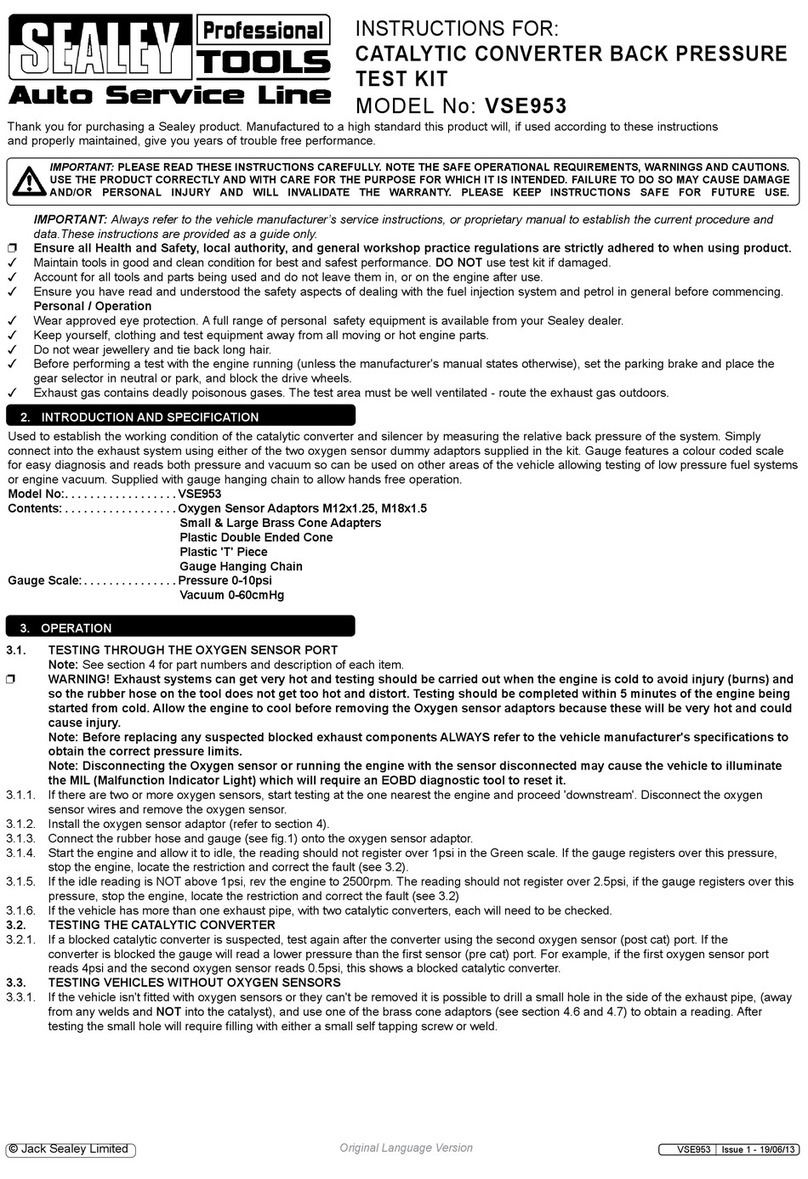
Sealey
Sealey VSE953 instructions
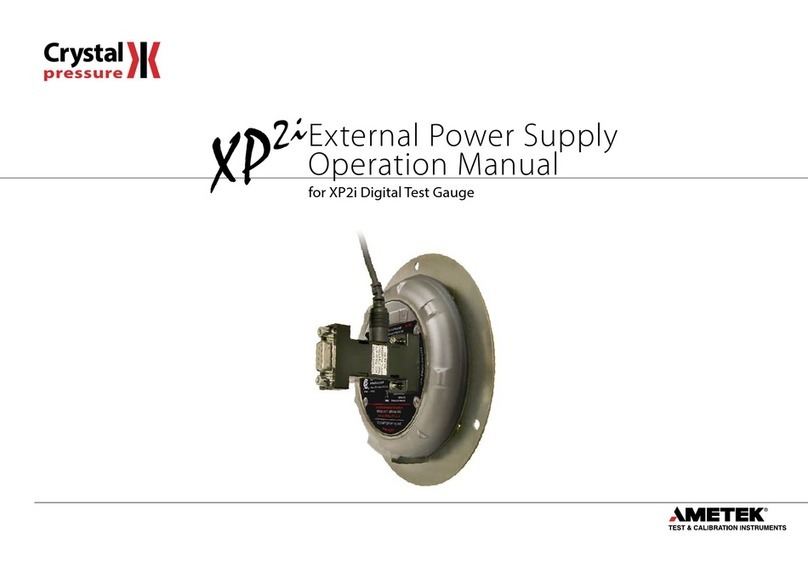
Crystal Pressure
Crystal Pressure XP2i Operation manual
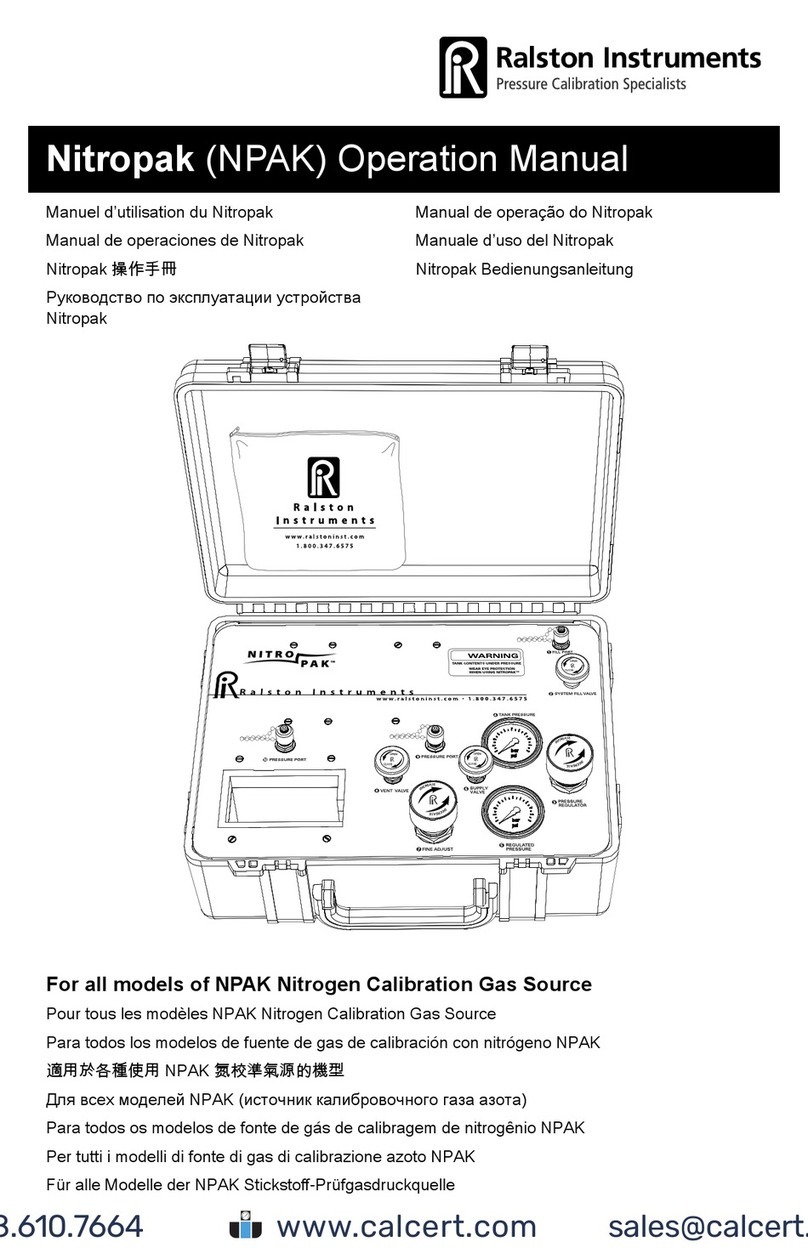
Ralston Instruments
Ralston Instruments NPAK-KIT3 Operation manual
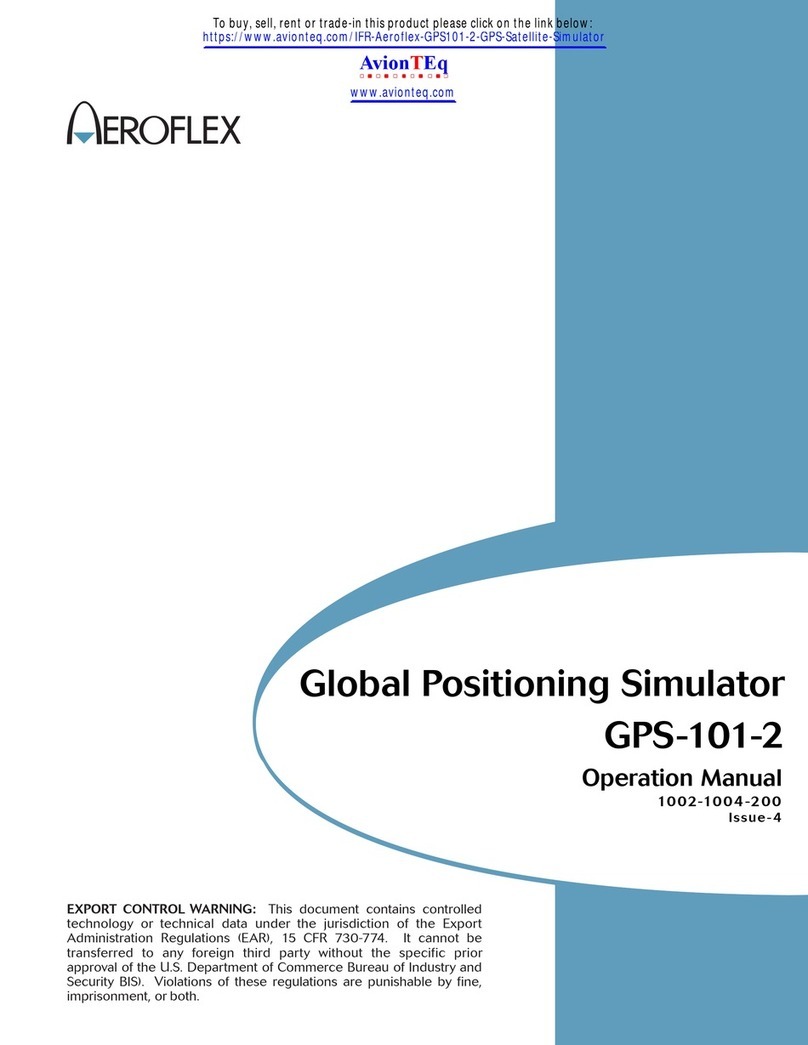
Aeroflex
Aeroflex GPS-101-2 Operation manual
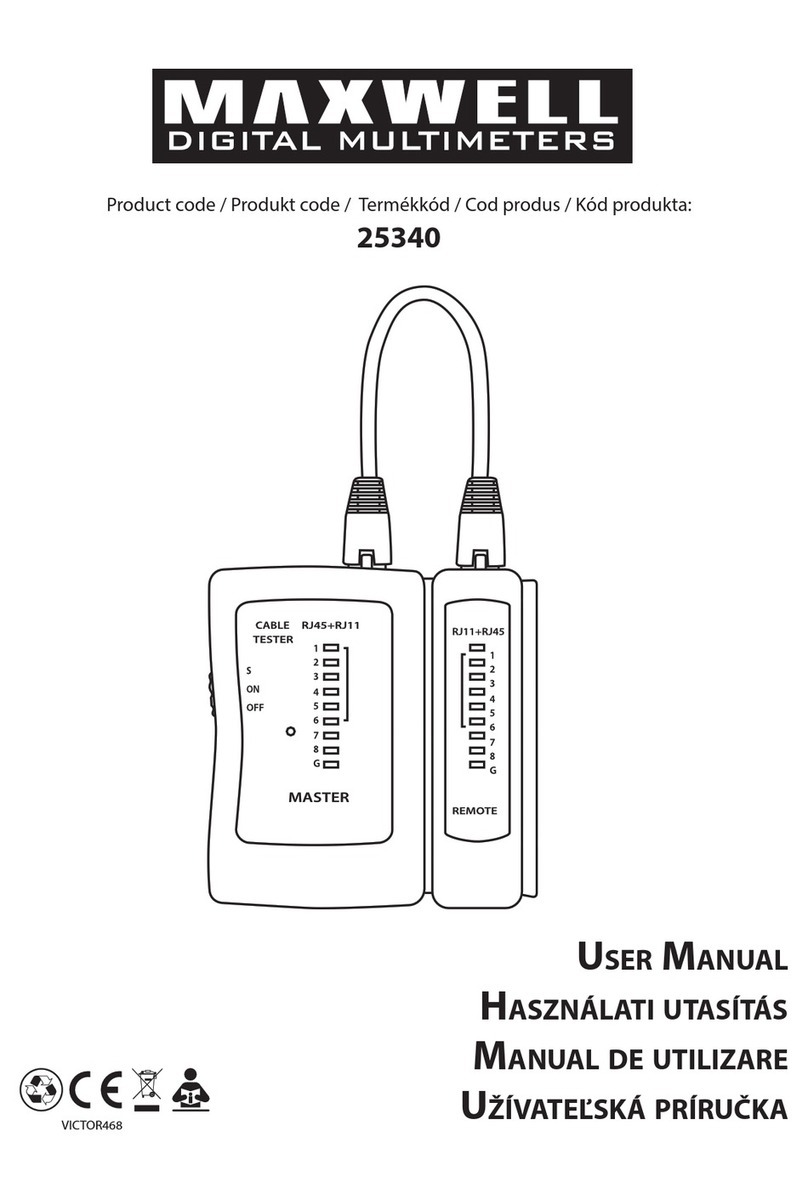
Maxwell Digital Multimeters
Maxwell Digital Multimeters MX-25340 user manual
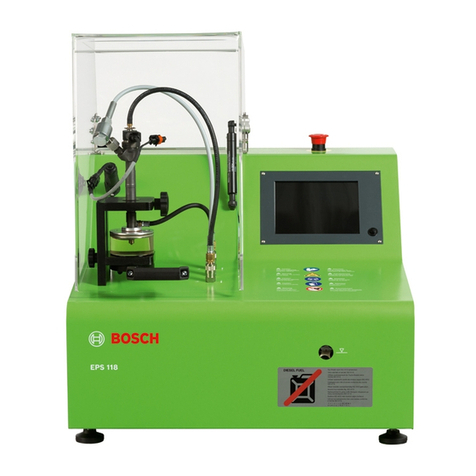
Bosch
Bosch EPS 118 Original instructions
